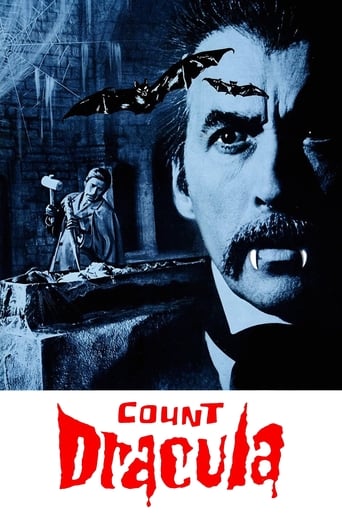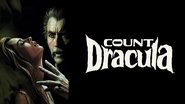alexanderdavies-99382
This version of Dracula should never have been advertised as being based upon the original book. For one thing, Jess Franco takes far too many liberties with the source material by changing and altering many elements. Ultimately though, it is the lack of a proper budget which defeats the movie. The production values are amongst some of the worst I've ever seen. None of the sets resemble Hungary or Romania in the slightest. From the opening scene, it becomes painfully obvious that Italy was frequently used for location filming.
Regarding the cast, most of them are terrible. They appear to be just going through the motions and give new meaning to the expression "sleep-walking." However, Christopher Lee, Klaus Kinski and Herbert Lom do their very best with such substandard material. Their performances are the ones to see. Christopher Lee manages to convey some depth into his familiar character and does well. Cast against type, Klaus Kinski makes for an effective Renfield. For once, he is a bit more sympathetic than most of his on-screen characters. Herbert Lom delivers a tough and steely determined Van Helsing.
This co-production might be worth a look for the sake of curiosity but don't expect a classic.
Cineanalyst
This cheap international production of Bram Stoker's novel "Dracula" is poorly conceived and poorly made in most ways, but it does have the draw of featuring two actors who played the titular role in other, better films, and is, thus, interesting for comparison. Christopher Lee had already played Dracula in the 1958 Hammer production and would continue to appear in the role in the studio's sequels. He again plays the Count here. Klaus Kinski would later play Dracula in Werner Herzog's remake of "Nosferatu" in 1979, and here he plays Renfield.Although championed as faithful to the book, as an adaptation, this "Dracula" features some bad deviations from Stoker's tale and in other ways is a poor imitation of prior "Dracula" films—especially the 1958 Hammer one. Although it adopts the gore and blood splatter from Hammer, it's, overall, a tamer version, and there's very little sex appeal here as opposed to some of the Hammer productions. This film also steals from the 1958 film the part where the Count lures Mina away, but adopts from the 1931 Universal picture the scenes of Dracula prowling the streets and entering a theatre. This stuff is absent from Stoker's original. Also absent from the book is Van Helsing's weird stroke, which in this film leaves him wheelchair bound and stuck at home with Mina while Quincy and Jonathan go to Transylvania. Also, in the final scenes, a fire motif is invented, with Van Helsing making a makeshift, fiery cross to ward off Dracula, and the Count is climactically burned to death in his coffin.There's a laughable scene involving taxidermic animals supposedly coming to life to threaten our heroes, some obvious dummy boulders in the climax, and the film makes the head-scratching mistake of trying to pass off docile German Shepherds as wolves. The fake bat gimmickry is far more tolerable by comparison. Overall, the main stylistic theme of director Franco's movie is an abundant reliance on zoom-ins.Lee and Kinski can't save this dull and ill-advised mess, but their characterizations are of some interest. Kinski as Renfield seems too true to art imitating life, as the actor really had been committed to a psychiatric hospital in years past, and his continued abnormal behavior was evidenced in his frequent-director Herzog's documentary "My Best Fiend" (1999). Unlike other portrayals of Renfield, Kinski plays him comatose, with occasional screaming and violent outbursts, including jumping out a window and choking Mina. Kinski's later stilted Nosferatu isn't that far removed from his Renfield, really, except his Dracula talks more and breaths heavier. Meanwhile, Lee got the opportunity to play a Count that is a somewhat closer approximation of Stoker's characterization than his Hammer iterations, although he still manages to play him mostly mute after his castle scenes. His mustached appearance and white-to- black hair transformation is closer to Stoker's description, too, than his wild-eyed sex beast in the '58 shocker.The final embarrassment is that the filmmakers of a documentary, "Cuadecuc vampire" (1971), of the making of this film, made a better movie.The next year, Franco made a looser, Sapphic Dracula adaptation, appropriately titled "Vampyros Lesbos" (1971).(Mirror Note: Contrary to the novel, Dracula has a wall mirror in his castle, which, for further inexplicable reasons, he points to in a scene with Jonathan—revealing to him his lack of a reflection. Although also contrary to the novel, a shadow disappearance shot is handled better later in the film.)
Leofwine_draca
Yet another adaptation of Bram Stoker's classic Gothic horror story, Dracula. What differentiates this one from the rest is the fact that a) it's Spanish b) it's closer to the plot of the book than some other adaptations I might care to mention. The director is none-other than the famed Jess Franco, a man with an extremely high output of work is only marred by the fact that a lot of his films are less than entertaining. Not in this case, though, as Franco gives us an atmospheric and at times frightening film. Also, released here on a 12 certificate in an uncut form, it proves that not all vampire films need blood and gore to be entertaining.There are many interesting things to look out for. Some are truly grand (such as the musical score, which is Gothic to the extreme and also scary, as well as movingly nostalgic, the kind of music you associate with old, creaky horror films) and other are plain comedic (such as the director's insistence of zooming in on people's faces and eyes, which is slightly overused and actually hilarious, considering that it's used to emote fear). There are also a high number of atmospheric scenes for a film of this type.The bit where the three vampire girls are being staked is done extremely well, better than the countless other versions I've seen, and all it takes is a splash of blood to shock you. Or the bit where the voice whispers "Lucy". There is also a comedic scene where the cast is menaced by some stuffed animals. It's so implausible when someone is shaking a stuffed fox at the camera you can't help but laugh. Even so these scenes come across as light relief, even if they were intended to be frightening, and they don't detract from the film in any way. The mood of the film and of the original story does come across extremely well.This is no doubt helped by the fine acting we have on display here. Christopher Lee looks even more impressive than his Hammer incarnation, and there is a great effect of him growing younger throughout the film. Just try to ignore his dodgy moustache. Solidad Miranda from VAMPYROS LESBOS also stars, bringing a certain charm to her minor role as Lucy, Dracula's first real victim. The part of Jonathan Harker is played by an unknown, but the fresh-faced man is pretty impressive in the role and evokes our sympathy, even if he is portrayed by a foreigner. Herbert Lom gives his usual understated performance and is convincing, if not very exciting. The best acting, however, comes from Klaus Kinski in a surprisingly non-speaking role as Renfield the madman. We really feel for him as he struggles to free himself from his cell in the asylum and he achieves this through his actions. He's simply brilliant, the best Renfield you are ever likely to see. In fact his performance would make the film worth watching on it's own, but you have all of these other factors too.The ending of this film has been widely criticised, as Dracula's burning coffin simply falls over the edge of a cliff. I was expecting the worst but I was pleasantly surprised, he even decays a la Hammer's Dracula. The special effects are underused, and therefore a welcome sight when they do appear (apart from a ridiculously cheesy rubber bat on offer). If you don't treat this film too harshly then you might just enjoy it, on a purely mechanical level though it has to be said it is pretty average. Nonetheless it's a lot of fun and all from an interesting perspective.
Rfischer8655
Oh how dated this film looks. Some movies outlast their era and still look fresh. Not this one. The acting is way overdone, and almost comical. Actors look self-conscious as if always aware of the camera. But what makes this almost unwatchable is the cinematography. I got dizzy with the constant zooming in and out on faces, objects, and scenery. The lens also seems to move back and forth in rooms always looking for subject matter. My gosh, leave the camera on the tripod and let the story do the telling.Finally, for a 1970 movie, the narrow aspect ratio and film quality is awful. Colors are blaring without any subtlety of in-between shades. That may be the fault of poor lighting technique. Sound was was often unsynchronized with the speaker. It almost looks like it was shot on someone's home 35mm camera.The story is fair, and seems to follow the original literature. But I was so distracted by the half-hearted production values, I lost interest. The best version for me is with Louis Jourdan in PBS's version only a few years later.




